Grapes: Diseases and Symptoms
Grapes: Diseases and Symptoms
Downy mildew
Disease symptoms- The fungus is an obligate pathogen which can attack all green parts of the vine.
- Symptoms of this disease are frequently confused with those of powdery mildew. Infected leaves develop pale yellow-green lesions which gradually turn brown. Severely infected leaves often drop prematurely.
- Infected petioles, tendrils, and shoots often curl, develop a shepherd's crook, and eventually turn brown and die.
- Young berries are highly susceptible to infection and are often covered with white fruiting structures of the fungus. Infected older berries of white cultivars may turn dull gray-green, whereas those of black cultivars turn pinkish red.
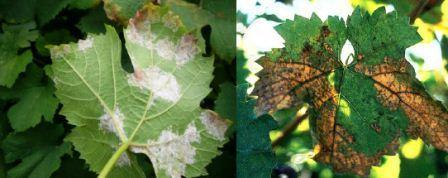
- The fungus overwinters mainly in the fallen leaves which are the source of primary infection. Secondary infection occurs by motile zoospores by splashing rain.
- The most serious outbreaks have been found to occur when a wet winter is followed by a wet spring and a warm summer with intermittent rains
Powdery mildew
Disease symptoms- Powdery mildew, caused by the fungus Uncinulanecator, can infect all green tissues of the grapevine.
- Tissues are generally susceptible to infection throughout the growing season.
- Diseased leaves appear whitish gray, dusty, or have a powdery white appearance. Petioles, cluster stems, and green shoots often look distorted or stunted. Berries can be infected until their sugar content reaches about 8%.
- If infected when young, the epidermis of the berry can split and the berries dry up or rot. When older berries are infected, a netlike pattern often develops on the surface of the berry.

- The powdery mildew fungus overwinters in dormant buds or as specialized structures on the surface of the vines. When conditions are favorable for growth of the fungus in spring, spores are produced, released, and cause new infections. Secondary spread of the disease can occur if spores are produced in these new infections.
- High humidity and moist weather favours the development of disease.
Anthracnose
Disease symptoms- Anthracnose, caused by the fungus Elsinoe ampelina, is also known as bird’s-eye rot from its appearance on the fruit.
- The disease appears first as dark red spots on the berry. Later, these spots are circular, sunken, ashy-gray and in late stages these spots are surrounded by a dark margin which gives it the “bird’s-eye rot” appearance. The spots vary in size from 1/4 inch in diameter to about half the fruit.
- The fungus also attacks shoots, tendrils, petioles, leaf veins, and fruit stems. Numerous spots sometimes occur on the young shoots. These spots may unite and girdle the stem, causing death of the tips. Spots on petioles and leaves cause them to curl or become distorted.

- The primary infection by diseased vines and secondary infection by wind-borne conidia.
- Continuous/intermittent rains and high humidity are responsible for the development of disease.
Greenaria bitter rot
Disease symptoms- This fungus can infect all green parts of the vine including leaves, tendrils, new shoots, as well as berries. However, mature leaves and ripe fruit are not susceptible. Infections of leaves first appear as red spots on the upper leaf surface in late spring.
- These circular spots enlarge and become tan to light brown with distinct, dark borders. Small, pinpoint black fruiting structures of the fungus often develop in the centers of these spots.
- Most serious damage usually occurs on the berries. On the fruit, infections first appear as whitish spots which enlarge to sunken areas with dark borders. Significant infections usually occur when the grape is pea-size or larger. As infection progresses, the fruit becomes black, wrinkled, mummified, and look like raisins. Infected grapes often shatter,leaving only the stem.
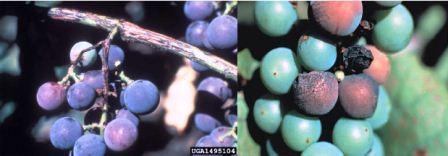
- The fungus overwinters on mummified berries on the soil or in old clusters still hanging in the vines. Secondary infections can occur when additional spores are produced on the newly infected tissues.
- Moisture and temperature above 20-25 °C favours the development of disease.
Bacterial leaf spot
Disease symptoms- The young growing shoots are affected first. Disease infects leaves, shoots and berries. The symptoms appear as minute water soaked spots on the lower surface of the leaves along the main and lateral veins.
- Later on these spots coalesce and form larger patches. Brownish black lesions are formed onthe berries, which later become small and shriveled.

- The pathogen survives in infected plant residue in soil and seed borne.
- The disease is more prevalent during June-August and again in February-March.
- Temperature range of 25-30 ºC and relative humidity of 80-90% is favourable for the development of the disease.
Alternaria blight
Disease symptoms- The disease attacks both leaves and fruits. Small yellowish spots first appear along the leaf margins, which gradually enlarge and turn into brownish patches with concentric rings. Severe infection leads to drying and defoliation of leaves.
- Symptoms in the form of dark brown-purplish patches appear on the infected berries, rachis and bunch stalk just below its attachment with the shoots.
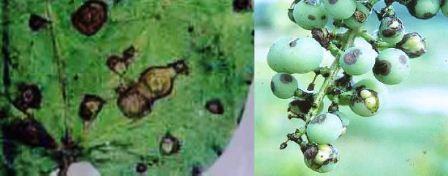
- The disease is externally and internally seed borne. The pathogen survives through spores (conidia) or mycelium in diseased plant debris or weed.
- Moist (More than 70% relative humidity) and warm weather (12-25 ºC) and intermittent rains favours disease development.
Black rot
Disease symptoms- The disease attacks the leaves, stem, flowers and berries. All the new growth on the vineis prone to attack during the growing season.
- The symptoms are in the form of irregularly shapedreddish brown spots on the leaves and a black scab on berries.
- Occasionally, small elliptical darkcoloured canker lesions occur on the young stems and tendrils. Leaf, cane and tendril infection canoccur only when the tissue is young, but berries can be infected until almost fully-grown if an activefungicide residue is not present.
- The affected berries shrivel and become hard black mummies.

- Pathogen survives in soil and plant debris.
- Warm and moist climate with extended periods of rain and cloudy weather favours the development of the disease.
Blue mould rot
Disease symptoms- Scanty growth - white and turn bluish green are seen.
- Decay the berries.
- Infected tissues become soft and watery.
- Infected berries emit a mouldy flavor.
- The fungus covers whole berries and it looks like bluish green in colour.
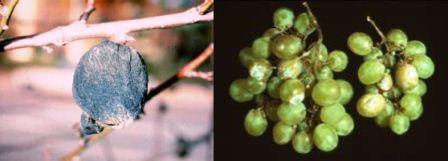
- Spores of this fungus are very common in the air and soil which are the source of infection.
- Blue mold is most common when temperatures are higher than 10-14°C.
- Free moisture for six hours or longer on the onion surface is necessary for infection to occur.
Black mould rot
Disease symptoms- It is a post-harvest disease. The fungus enters the berries through the injuries caused due to poor post-harvest handling operations.
- The pulp of infected berries is reduced is reduced to watery consistency.
- Berries look black in colour.
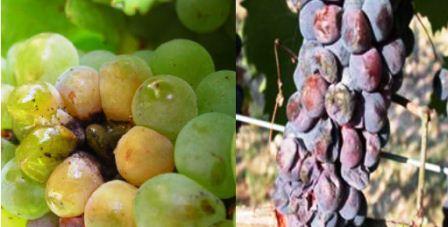
- Spores of this fungus are very common in the air and soil which are the source of infection.
- Black mold is most common when temperatures are higher than 30°C (86°f) in the field or 24 °C in storage.
- Free moisture for six hours or longer on the onion surface is necessary for infection to occur.
Green mould rot
Disease symptoms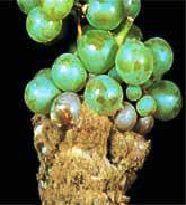 It is a post-harvest disease. The fungus enters the berries through the injuries caused due to poor post-harvest handling operations.
It is a post-harvest disease. The fungus enters the berries through the injuries caused due to poor post-harvest handling operations.- Infected berries are discolored yellowish green, and affected fruits shrivel.
- Masses of powdery green spores generally covered the bunch of grapes.
- Spores of this fungus are very common in the air and soil which are the source of infection.
- Green mold is most common when temperatures are higher than 30°C in the field or 24°C in storage.
- Free moisture for six hours or longer on the surface is necessary for infection to occur.
Rhizopus rot
Disease symptoms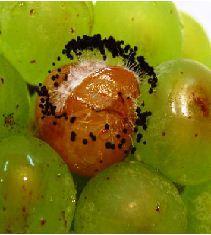 Round irregular, light brown and water soaked lesion appear on fruits.
Round irregular, light brown and water soaked lesion appear on fruits.- Decaying fruits emits fermented, moudly smell.
- Conidia aseptate, small and globose
- It is a post-harvest disease. Under warm and moist conditions the fungus grows rapidly producing acoarse grey mat of mycelium.
- Injury caused to the berries by tight packing and storage temperaturehelp the fungus grown during storage. If the infected berries are trimmed at harvest, it does not occurafter harvest under ideal storage conditions.
- Spores of this fungus are very common in the air and soil which are the source of infection.
- Black mold is most common when temperatures are higher than 30°C in the field or 24°C in storage.
- Free moisture for six hours or longer on the surface is necessary for infection to occur.
Botrytis bunch rot or gray mold
Disease symptoms- One or more berries of a cluster show signs of decay just before harvest. The decay may progress to include most of the berries in a cluster. The infected fruit may become covered with a grayish-tan powder containing the spores of the fungus.
- Berry stems and cluster stems may be invaded, causing them to shrivel.
- When the fungus decays berries low in sugar, the rotting berry has a sour odor and taste.
- If the berries are nearly mature and have a high sugar content, the decaying berry is quite firm, dry, and somewhat sweetish to the taste. Berries that have split or have been punctured often are attacked by other organisms, resulting in a sour or moldy decay.
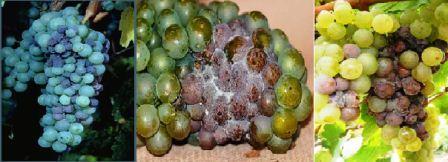
- Fungus survives in all decaying vegetation. Its spores are present in the vine yard throughout the year.
- Brown mold is most common when temperatures are higher than 30°C in the field or 24°C in storage.
- Free moisture for six hours or longer on the surface is necessary for infection to occur.
Rust
Disease symptoms- The symptoms are in the form of numerous orange coloured pustules on the lower surface of the leaves. In case of severe infection such pustules cover the entire leaf surface leading to severe defoliation.

- The pathogens reproduce and survive in spots on leaves or stems and in fallen plant host debris.
- Moisture and temperature above 20° C favours the development of disease.
Foot rot
Disease symptoms- Roots show black, sunken, necrotic lesions. In cross section, the base of the trunk appears necrotic and xylem vessels may be black in colour.
- Leaves may appear to be water stressed or scorched, and vines may be stunted and/or killed.
- Cylindrocarpon may occur in combination with other plant pathogens.
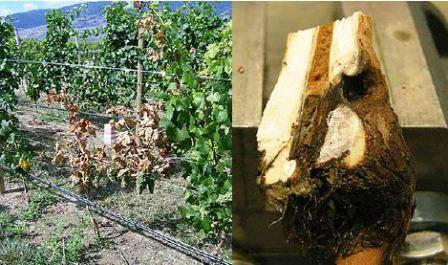
- Cylindrocarpon is a common soil-borne fungus which causes root rot in many plant species.
- It survives in soil as mycelium and also produces conidia (spores) and chlamydospores (spores that can survive adverse conditions).
- Moderate humidity and moist conditions
IPM for Grapes
To know the IPM practices for Grapes, click here.
Source: NIPHM and Directorate of Plant Protection, Quarantine & Storage
Last Modified : 2/13/2020
© C–DAC.All content appearing on the vikaspedia portal is through collaborative effort of vikaspedia and its partners.We encourage you to use and share the content in a respectful and fair manner. Please leave all source links intact and adhere to applicable copyright and intellectual property guidelines and laws.
RELATED ITEMS
Blackgram & Greengram: Diseases and Symptoms
This topic covers the Information related to Disea...
Jack Fruit Diseases
This topic provides information about Jack Fruit: ...
Amla Diseases
This topic covers information about Amla Diseases ...
Fenugreek Diseases
This topic covers information about Fenugreek Dis...
